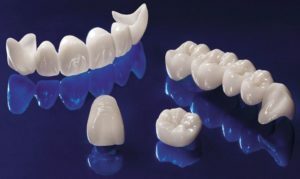 Crown is a non-removable design, which is one of the types of prosthetics. Its installation is used in cases where the tooth has a high percentage of destruction and treatment with the use of sealing is not possible. Also, crowns are established with a pronounced anomaly of one or more teeth for aesthetic purposes.
Crown is a non-removable design, which is one of the types of prosthetics. Its installation is used in cases where the tooth has a high percentage of destruction and treatment with the use of sealing is not possible. Also, crowns are established with a pronounced anomaly of one or more teeth for aesthetic purposes.
In any case, this is a rather complicated dental procedure that requires a certain amount of time and manipulation. Therefore, the emergence in patients of a variety of issues related to it, it is quite natural.
Contents
- Indications for
- Installation of the crown from "A" to "Y"
- Preparatory stage
- Laboratory stage
- Fitting and fixing
- Methods for restoration of the crown part
- Features of manufacturing and installation of die-cast crowns
- What are the patients most interested in?
Indications for installation
The decision to install a crown can be taken only after consulting a dentist, and often for this, it also requires a radiographic examination. Usually such prostheses are put under certain conditions:
-
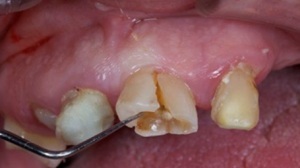 Most often, is used to install the crown with strong tooth destruction ( about 70% or more).In this case, filling, building up and other methods of treatment are not effective enough, they do not allow the correct distribution of the chewing load and eventually lead to a split tooth base. The installed crown will be able to protect the tooth from further destruction and allow it to fully perform the chewing function.
Most often, is used to install the crown with strong tooth destruction ( about 70% or more).In this case, filling, building up and other methods of treatment are not effective enough, they do not allow the correct distribution of the chewing load and eventually lead to a split tooth base. The installed crown will be able to protect the tooth from further destruction and allow it to fully perform the chewing function. - Congenital or acquired dentoalveolar anomalies of , correction of which with braces systems and other corrective devices is impossible.
-
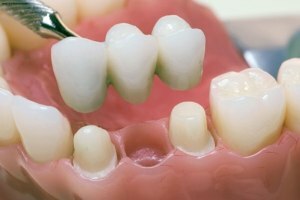 The need to install a bridge prosthesis .In this case, the crowns are placed on healthy teeth, which serve as a support for the prosthetic construction.
The need to install a bridge prosthesis .In this case, the crowns are placed on healthy teeth, which serve as a support for the prosthetic construction. - Loss of one or more teeth as a result of an injury, provided that they retain healthy roots.
- In the case of , when the tooth enamel is prone to the strong erasure of the , a crown is mounted on it to protect it from further damage and other negative factors.
- If the color of the tooth enamel is strongly altered, when it is impossible to fix the situation with veneers and lumineers.
A dentist may recommend the installation of crowns in order to preserve or prevent further destruction of the chewing element in some other cases.
Setting the crown from "A" to "I"
Setting the crown on the tooth goes in several stages. This is not an easy procedure, requiring more than one visit to the dentist.
Preparatory stage
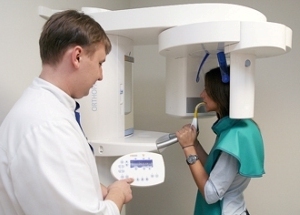 In the first stage, a complete examination of the oral cavity is made, the condition of the teeth is clarified, if necessary, X-rays are taken. Based on the results of the examination, the dentist gives recommendations on prosthetics and draws up a detailed treatment plan.
In the first stage, a complete examination of the oral cavity is made, the condition of the teeth is clarified, if necessary, X-rays are taken. Based on the results of the examination, the dentist gives recommendations on prosthetics and draws up a detailed treatment plan.
After this, the preparation of the tooth for the installation of a crown begins.
This is an extremely important point in the process of prosthetics, requiring a very responsible attitude:
- First of all, the problem tooth is subjected to depulpation and the sharpening of .When grinding from the tooth, remove the outer layer of hard tissue, in thickness it is equal to the thickness of the crown. Depending on the prosthesis being installed, this may be a small layer or thick enough.
-
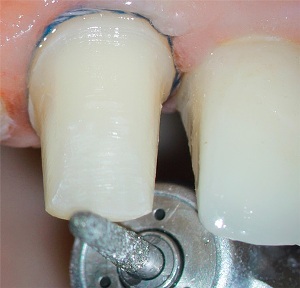 is administered to the treatment of chewing elements affected by caries. The canals of teeth are filled, and the plaque and stone are cleaned.
is administered to the treatment of chewing elements affected by caries. The canals of teeth are filled, and the plaque and stone are cleaned. - If the prosthesis is to be installed on one of the front teeth( single root), then is sure to remove the nerve from it. This is necessary in order to exclude the possibility of a pulp burn during the turning process. When installing crowns on multi-root teeth this is not required, since the risk of burns during their turning is minimal.
- If the tooth is severely damaged , the dentist first removes the nerve from it and seals the canals, then restores its coronal part with the help of a filling material.
- If a live tooth is being applied to the prosthesis, then its turning is performed under local anesthesia .
Laboratory stage
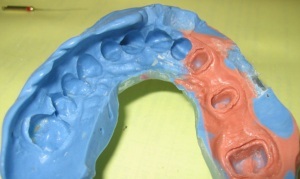
In the photo of the impression for the bridge prosthesis
At the end of the preparatory stage, the dentist removes molds from the patient's dental rows with the help of a special viscous mass. On their basis, first plaster models of teeth are created, and then the crowns themselves.
The process of manufacturing dentures takes a lot of time, so for this period, the patient is offered temporary crowns made of plastic.
In the case of prosthetics of the front teeth, they hide the unsightly obtichnye stump. In addition, the chewing elements in this state are very vulnerable to mechanical attack and infection. Temporary prostheses help protect the teeth prepared for installation and enable them to fully perform the chewing function.
Fitting and fixing
Before the final stage of the crown manufacturing, it is absolutely necessary to sample it to the patient. This is necessary for assessing the quality of work, the density of adherence of the prosthesis and the detection of possible inaccuracies. If necessary, the prosthesis is being improved.
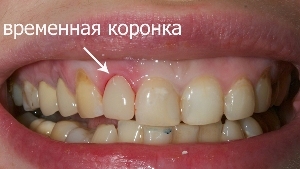 Before the final installation of the crown on the tooth, the latter is fixed to the temporary cement and is worn for some time.
Before the final installation of the crown on the tooth, the latter is fixed to the temporary cement and is worn for some time.
Usually this period ranges from two weeks to a month. This is necessary in order to follow the reaction of the tooth to the installation of the prosthesis, to check whether the patient's bite is not broken, whether he is experiencing discomfort.
At the end of the trial period, the prosthesis is easily removed by the dentist, all temporary cement is carefully removed and the crown is permanently installed. This step is carried out under condition of absence of any complaints of the patient during the time fixation.
Methods of restoration of the coronal part
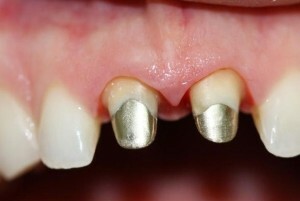
In the photo, the insert in the tooth for the crown
In the case when the tooth is destroyed very strongly, before the crown is installed, the restoration of its part located on the surface of the gum is required.
This is possible in two ways:
- Pin. Such restoration is carried out by screwing into the sealed tooth channel of the pin. Then a seal of special material is put on it. Only after that the tooth is grinded.
- Concentrated tab. More reliable and desirable is the restoration with the help of a tabbed insert. It is a construction that has a root and crown parts and is made by specialists in the denture laboratory. The root part of the dental tab is necessary for fixation in the canals of the tooth, and the crown part is already prepared for the installation of the prosthesis.
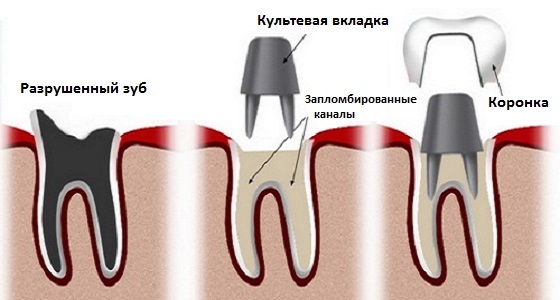
The photo shows the installation of a crown-shaped insert for the crown of a tooth
Features of manufacturing and installation of stamped crowns
For manufacturing stamped crowns, a clinical and laboratory stage is necessary. Clinical includes:
-
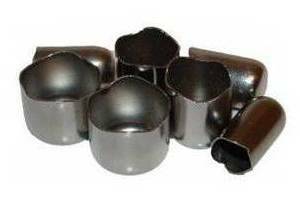
Die-punched crowns
tooth preparation, its grinding;
- choice of crown color;
- removal of an impression of the dentition and transferring it to the dental laboratory.
After this, the laboratory stage follows, during which the plaster model of the patient's teeth is made on the basis of the impression. Then it is applied to the melted wax to give the anatomical crown, after which a gypsum stamp is made.
In the future, it is replaced with an alloy of light metal and the most suitable metal sleeve is selected, which is given the desired shape with a screw press.
In the end, polishing and grinding of the crown is carried out, and it is transferred to the dental clinic.
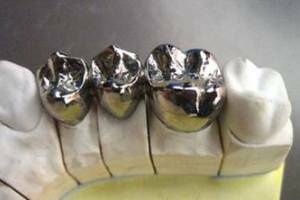 Stamped crowns have very thin walls, so for their installation requires a very small layer of tooth enamel. Their installation is possible in cases where at least 30-40% of the crown part of the tooth is preserved. In the production of steel, less gold is used.
Stamped crowns have very thin walls, so for their installation requires a very small layer of tooth enamel. Their installation is possible in cases where at least 30-40% of the crown part of the tooth is preserved. In the production of steel, less gold is used.
First, the metal prosthesis is temporarily installed and the tooth reacts to it. If the patient does not experience discomfort, the prosthesis has the right shape, is close enough to the stump and does not cause a malocclusion, then it is removed and cleaned of temporary cement.
After this, the stamped crown is permanently mounted on the glass ionomer or zinc-phosphate cement.
What are the patients most interested in?
Is it painful to put a crown?
Any dental procedure causes most patients some discomfort.  During the installation of crowns on the teeth, the most unpleasant is the initial stage - the preparatory stage, where the teeth are drilled, the root canals are cleaned and sealed, and the prosthesis is turned over.
During the installation of crowns on the teeth, the most unpleasant is the initial stage - the preparatory stage, where the teeth are drilled, the root canals are cleaned and sealed, and the prosthesis is turned over.
But considering the fact that crowns are most often placed on dead teeth, the probability of painful sensations is reduced to zero. If a healthy, live tooth is exposed to the prosthesis, then all manipulations at the preparatory stage are carried out using local anesthetics. The very same installation of the crown is absolutely painless.
How long does the procedure take?
Setting the crown is a long process. It is due to the fact that it is carried out in several stages. 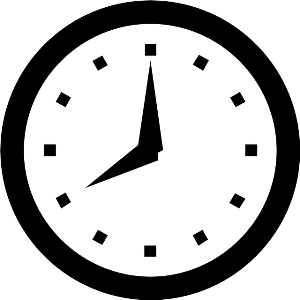 It is usually enough for 1 to 2 visits to the dentist for the preparatory stage, but it may be required more. The time of visits directly depends on the condition of the prosthetic tooth.
It is usually enough for 1 to 2 visits to the dentist for the preparatory stage, but it may be required more. The time of visits directly depends on the condition of the prosthetic tooth.
Laboratory manufacture of a crown takes a long time. This process is very complex and can last several weeks.
After the crown is ready it is installed to the patient with temporary cement for 2-4 weeks. Only after this the prosthesis is fixed definitively. Thus, from the first visit to the dentist before the final result can be 1-2 months, and in some cases more.
Can I put crowns on living teeth?
Crowns can be installed on live teeth in cases where they are not single-rooted and their condition does not require removal of the nerve. And also it is possible at the bridge prosthetics with installation of crowns on healthy basic chewing elements.
The installation of crowns on the teeth requires a lot of time. But the modern level of dentistry makes it possible to carry out this procedure completely painlessly, and the prostheses to be installed look absolutely different from real teeth and are able to fully perform the chewing function.
